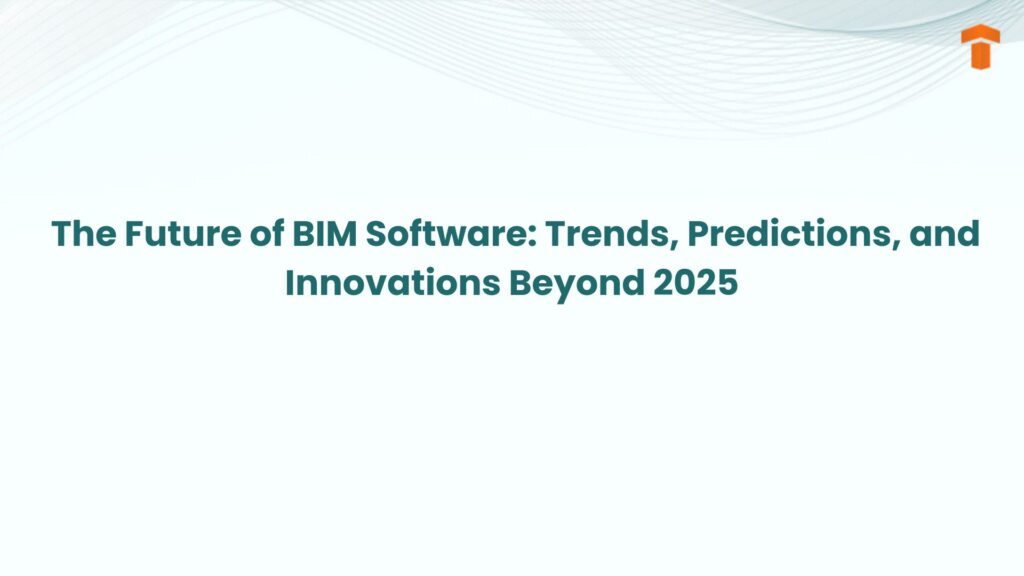The Future of BIM Software: Trends, Predictions, and Innovations Beyond 2025

Introduction
BIM Software has already redefined how we plan, design, construct, and manage buildings and infrastructure. As we move beyond 2025, this digital cornerstone of the architecture, engineering, and construction (AEC) industry is set to evolve in unprecedented ways. From AI-assisted modeling to real-time digital twins, BIM Software is poised to unlock new efficiencies, capabilities, and collaboration methods.
In this forward-looking article, we’ll explore the emerging trends shaping the future of BIM Software, how the industry is preparing for the next digital leap, and the critical role that institutions like Technostruct Academy play in cultivating the professionals of tomorrow.
Why the Future of BIM Software Matters
The construction sector is undergoing a massive digital transformation. The integration of technologies like artificial intelligence (AI), the Internet of Things (IoT), extended reality (XR), and blockchain are reshaping the role of BIM Software from a static modeling tool to an intelligent, dynamic project platform.
As we look ahead, understanding the trajectory of BIM Software is essential for businesses and professionals who want to stay competitive in a technology-driven industry.
Top Trends Defining the Future of BIM Software
-
Digital Twins & Real-Time Data Integration
The concept of a digital twin—an exact digital replica of a physical asset—is gaining momentum. BIM Software will evolve to support live data streams from buildings and infrastructure via IoT sensors, enabling real-time monitoring, predictive maintenance, and operational optimization.
Example: A digital twin of a smart hospital can monitor HVAC performance, occupancy levels, and energy consumption in real time, offering actionable insights for facility managers.
-
AI-Powered Design Automation
Artificial Intelligence is set to transform how BIM Software functions. AI algorithms can optimize layouts, suggest design alternatives, and automate repetitive modeling tasks.
Future Features May Include:
-
AI-assisted clash detection and resolution
-
Automated generation of floor plans based on user inputs
-
Energy efficiency optimization during the early design phase
-
Generative and Parametric Design
Tools like Dynamo (for Revit) and Grasshopper (for Rhino/Archicad) allow users to create rules-based designs that automatically adapt to input variables. Expect future BIM Software to take generative design mainstream, integrating it natively for architecture and engineering applications.
Use Case: Generating thousands of design options that maximize daylight, reduce heat gain, and optimize space—all within BIM Software.
-
5D, 6D, and 7D BIM Expansion
While 3D modeling is foundational, additional “dimensions” of BIM are gaining importance:
-
4D: Time/scheduling (construction sequencing)
-
5D: Cost estimation and budgeting
-
6D: Sustainability and energy analysis
-
7D: Facility and asset management
The future of BIM Software lies in seamlessly managing all these dimensions within a single platform.
-
Cloud-Native and Collaborative Platforms
Cloud-based BIM Software such as Autodesk Construction Cloud and Trimble Connect are setting a precedent for real-time, multi-user collaboration. Future solutions will be entirely cloud-native, requiring no local installations, and enabling simultaneous editing, live issue tracking, and automated backups.
Benefits:
-
Instant access to models from any device
-
Real-time team collaboration across time zones
-
Integrated project communication and version control
-
XR (Extended Reality) Integration: AR, VR, and MR
BIM Software will increasingly support immersive experiences. Imagine stepping into a virtual construction site before ground is broken or overlaying AR models on-site for verification.
Applications:
-
VR walkthroughs for stakeholder engagement
-
AR-guided construction tasks
-
MR for clash detection and site logistics planning
-
Blockchain for Data Security and Contracts
In the coming years, BIM Software may incorporate blockchain to:
-
Securely track changes in models
-
Create smart contracts for automated approvals
-
Maintain tamper-proof project logs
This will enhance trust, accountability, and compliance across stakeholders.
Technostruct Academy: Preparing for the Future of BIM Software
As BIM Software becomes more intelligent, immersive, and integrated, professionals will need advanced skills beyond just Revit or Navisworks. Technostruct Academy is ahead of the curve in equipping learners with the tools and mindset needed to thrive in this future landscape.
Here’s how Technostruct Academy is shaping future-ready BIM talent:
-
Training in Emerging Tools
In addition to industry staples like Revit and Navisworks, Technostruct Academy introduces learners to Dynamo, Grasshopper, BIM 360, and cloud collaboration platforms—bridging the gap between current and future tech stacks.
-
Digital Twin Projects
Students engage in projects that simulate digital twin environments, incorporating IoT data and lifecycle modeling—an essential aspect of next-gen BIM Software.
-
AI & Automation Awareness
Courses include exposure to automation techniques, parametric modeling, and AI-assisted workflows, preparing students to adapt to future tools.
-
XR Integration
Technostruct Academy partners with firms to provide training in virtual and augmented reality environments. This prepares learners to build models for immersive applications.
-
Certification for Global Careers
Recognized certifications from Autodesk and other BIM Software leaders ensure that graduates can work on projects around the world, regardless of how the tools evolve.
Predictions for BIM Software Beyond 2025
-
Self-Updating Models: BIM Software will integrate with sensors and AI to update as-built conditions automatically.
-
No-Code BIM: User-friendly interfaces will allow stakeholders with no coding experience to create and modify intelligent models.
-
Integrated Sustainability Dashboards: Carbon footprint, water usage, and life cycle impacts will be tracked within the BIM environment.
-
City-Wide BIM Platforms: Governments will use BIM Software for entire cities, integrating roads, utilities, and public infrastructure into digital twins.
Industries Poised for BIM Disruption
-
Healthcare: Smart hospitals with AI and IoT-enabled operations.
-
Transportation: BIM-led planning for highways, metros, and smart airports.
-
Education: Smart campuses with efficient space planning and asset management.
-
Energy: Renewable infrastructure and sustainable utility grids modeled in BIM Software.
Conclusion
The future of BIM Software is intelligent, immersive, and deeply integrated into every aspect of the built environment. As technologies converge and the demand for sustainable, data-driven construction grows, BIM Software will be the foundation of how we design and manage our world.
For professionals in architecture, engineering, or construction, staying ahead means not just learning today’s tools—but preparing for tomorrow’s innovations. With its forward-thinking curriculum and real-world exposure, Technostruct Academy is the ideal launchpad for those looking to lead the digital transformation of the AEC industry.
BIM Software is the future. Are you ready to build it?




